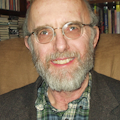SAN JOSE, CA—My personal high point of CLEO this year was speaking at a three-hour symposium on Sunday afternoon that honored the legacy of Theodore Maiman, almost exactly 48 years after he demonstrated the world’s first laser at Hughes Research Laboratories (Malibu, CA). A standing-room-only audience of more than 500 people filled the room and I was delighted to share the podium with Maiman’s wife Kathleen, and with people who worked with Maiman during his long and productive career.
Kathleen Maiman opened the symposium by displaying a replica of the first laser, and then gave the audience a picture tour of her late husband’s life and work. One highlight was a copy of his notes from his first laser demonstration, a particularly remarkable achievement because it worked the first time. She showed many photos of Maiman with friends and colleagues, including his assistant in the laser demonstration, Irnee D’Haenens, who sadly died in December, just seven months after Maiman. One memorable photo showed Maiman receiving an award from President Lyndon Johnson; another showed him dressed as a pirate with his wife by his side. As an old Dick Tracy fan, I got a kick out of a cartoon tribute given to Maiman by artist Chester Gould.
David Hanna of the University of Southampton (Southampton, UK) made the important historical observation that the first ruby laser was 10 orders of magnitude brighter at its wavelength than previous thermal sources, and that since then we’ve gained another 10 orders of magnitude.
My talk stressed the originality, elegance, and importance of Maiman’s ruby laser. His pulsed laser with high peak power was an original design that opened new opportunities not envisioned for the continuous-wave laser oscillators others were trying to build. It was an elegant design, simple and robust enough that TRG and Bell Labs replicated it within weeks—a remarkably short time. Thanks to that design, lasers were soon in the hands of engineers, scientists, and physicians working to develop laser applications.
After the talks were over, I got a big kick from seeing a 1962-vintage Hughes ruby laser, displayed by attendee Robert Hess, a technician in the San Jose area who had restored it to working order.
In his later years, Maiman became heavily involved with medical laser research. Three final speakers—Nicholas Razum, formerly of the Western Institute of Laser Treatment (Santa Barbara, CA), Gregory Keller, founder of the Western Institute, and Delwin McCarthy of Millennium Dental Technologies (Cerritos, CA)—described research on laser healing, bio-stimulation, and skin treatment that they hope will become a living legacy.
About the Author
Jeff Hecht
Contributing Editor
Jeff Hecht is a regular contributing editor to Laser Focus World and has been covering the laser industry for 35 years. A prolific book author, Jeff's published works include “Understanding Fiber Optics,” “Understanding Lasers,” “The Laser Guidebook,” and “Beam Weapons: The Next Arms Race.” He also has written books on the histories of lasers and fiber optics, including “City of Light: The Story of Fiber Optics,” and “Beam: The Race to Make the Laser.” Find out more at jeffhecht.com.
